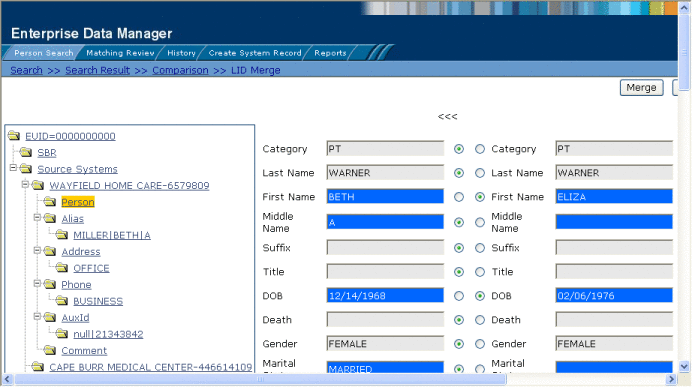Combining Patient Information
When you determine that two patient profiles represent the same patient, you can merge the profiles to form one profile that contains the patient’s most current information. You can also merge system records within one profile or from one profile to another. The resulting profile is called the Merge Result Record. The SBR for the surviving profile or profiles is automatically recalculated based on the system records involved in the merge.
You can display the patient profiles to merge using the Person Search function or the Matching Review function. This section describes how to merge records using the Person Search function. For information about merging records using the Matching Review function, see Merging Potential Duplicate Patient Profiles.
For instructions on combining patient information, see the following topics:
Merging Patient Profiles
When you merge patient profiles, all of the system records associated with the non-surviving patient profile are transferred to the surviving patient profile. The non-surviving profile is given a status of merged and is no longer active. The SBR of the surviving profile is recalculated based on the new system records that were added to the profile due to the merge. After merging two profiles, review the system records in the active profile to determine whether any of them should be deactivated.
Figure 60 Comparison Page - Merging Patient Profiles

 To Merge Patient Profiles
To Merge Patient Profiles
-
Perform a search for the patient profiles you want to merge using any of the search procedures described in Searching for Patient Profiles.
-
Select the check boxes to the left of the two profiles you want to merge in the results list.
-
In the first cell of the results table, click Compare Records.
The Comparison page appears.
-
Determine which of the two profiles you want to keep, and then click the EUID Merge arrows pointing toward that profile.
The merge result profile appears, allowing you to view the profile that will be saved after the merge.
-
Click Confirm to finalize the merge, or Cancel to return to the Comparison page and review the profiles again .
Merging System Records on the Patient EDM
You can merge a system record from one patient profile into a system record from another patient profile or you can merge two system records in one profile, as long as both system records originated from the same system. You can also specify which, if any, information to save from the non-surviving system record. When you merge system records, the non-surviving system record is transferred into the patient profile of the surviving system record, and is given a status of merged. The SBR of the surviving profile is automatically recalculated.
Figure 61 Merging System Records

Note –
If you do not specify which child objects to retain during a merge, the master index application chooses for you; however, the Patient EDM can be configured such that you must select which child objects to retain for certain object types (see your system administrator for more information about how your Patient EDM is configured). If specifying child objects to retain is optional and you do not manually select the child objects, the default is to retain all child objects profiles of a unique type from both system records. If there are any child objects of the same type, the default is to retain only the child object of the surviving system record. For example, if one system record has an office address and the other has a home address, both addresses are retained; but if both system records have a home address, the address of the surviving system record is retained.
 To Merge System Records
To Merge System Records
-
Perform a search for the patient profiles whose system records you want to merge using any of the search procedures described in Searching for Patient Profiles.
-
Select the check boxes to the left of the two profiles containing the system records you want to merge.
-
In the first cell of the results table, click Compare Records.
The Comparison page appears with the differences between the two records highlighted in blue.
-
Highlight the Person object of the system records you want to merge in the EUID trees.
Two LID Merge arrow buttons appear at the top of the page.
-
Click the LID Merge arrows pointing toward the profile containing the system record you want to retain.
-
To retain any fields from the non-surviving system record, select the Person objects in the system objects to merge, and then select the option button next to each field you want to keep.
-
To specify which child objects of the two system objects to retain, do the following for each type of child object:
-
In the upper portion of the page, click Merge.
The merge result record appears, allowing you to view the information that will be saved in the SBR after the merge.
-
Click Confirm to finalize the merge or click Cancel to return to the Comparison page and review the profiles again.
After you merge two system records, the surviving system record is updated and the non-surviving system record is transferred to the “merge to” patient profile and marked as merged. The SBRs for both patient profiles involved in the merge are recalculated. If the “merge from” patient profile no longer has any system records, it is deactivated.
- © 2010, Oracle Corporation and/or its affiliates
